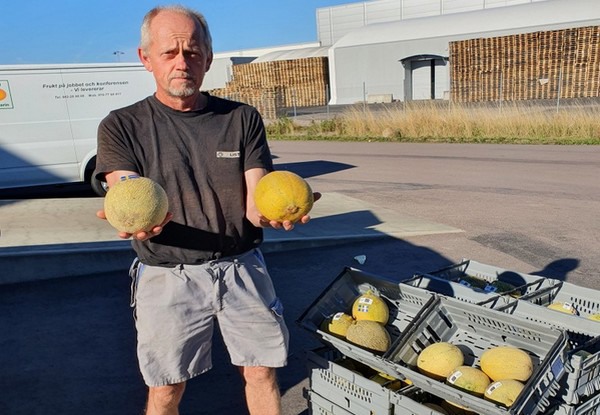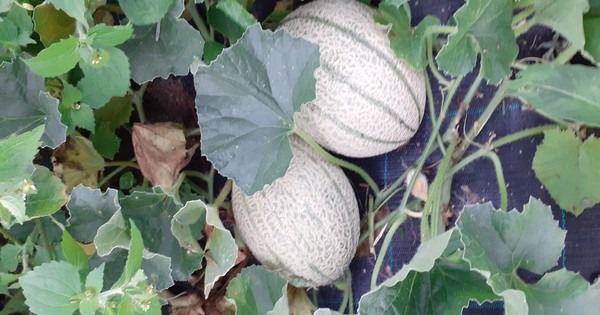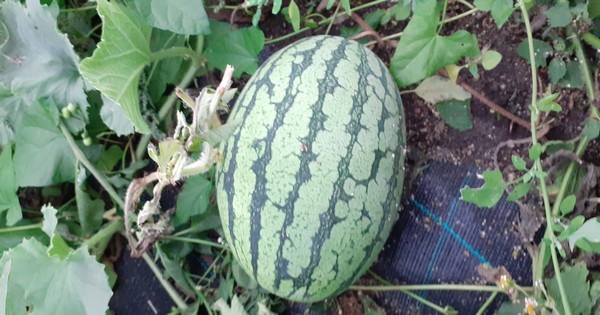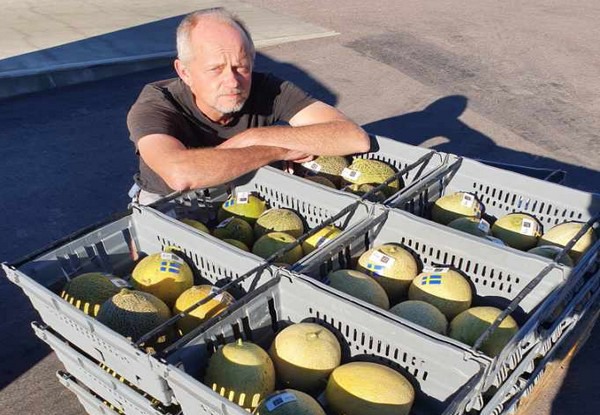Sweden is described as a cold dark place just below the North Pole, with nine months of hard winter and three months of slightly poorer skiing conditions, how can anyone get the idea to grow melons outdoor there?
Ingmar Nilsson, a second generation melon grower in Frillestad outside of Helsingborg, Skåne, Sweden tells us what his reality looks like and how he uses the warming climate to his advantage to grow sweet tasting melons and watermelons.

Ingmar Nilsson delivering his Swedish grown melons
”Sweden is dark… from mid October until mid March, but then the length of the day rapidly increases, until midsummer when the day slowly gets shorter again. As a comparison, on 21 June we have 17:35 hours of daylight in the South of Sweden, and 24 hours in the North, compared to 14:48 in Alicante, Spain at the same date, which is what we have in early May, or mid-August. That and the fact that the Swedish summer usually have a temperature between 18-30 degrees C in daytime, and 12-20 degrees night time, gives the melons quite decent temperatures to grow, and plenty of light makes rapid growth,” explains Nilsson.
Although the weather is not the most reliable, it can change from 15 degrees and rain to 30 degrees and sun, and back within a week. It can also remain 15-18 degrees for the entire summer, just to be 25-30 degrees and constant sun throughout the summer the following year.

But how does anyone get the idea to grow something as heat and sun loving as melons in a country with such uncertain growing conditions?
”Well… Let me start by saying that melon cultivation does have quite a long history in Southern Sweden. The commercial cultivation started just after the ending of WW2 in the late 1940’s. Back then almost all melons were grown in hotbeds, that was moved around in the fields every year. It was a very labour intense cultivation system, but it gave high yields and secured a decent harvest every year. As a comparison my father who grew melons in hotbeds from 1947-2002, had an average yield of 4 tons/year from 2 500 m2,” Nilsson fondly remembers.
He says the Swedish melons have always been the netted Italian type, but often much larger. From the start until the mid 1970’s it was only open pollinated variety's, that turned into local variety's due to that the growers produced their own seed. New and smaller variety's were introduced from the seeding companies, like ”Herma” and ”West”, but these changed into local varieties as the years passed by.
”In the mid 1970’s the first hybrid ’Aroma’ was introduced, and rapidly became the Swedish melon, and stayed so until 2015 when it disappeared from the market due to bad parental material. It was not suitable for outdoor cultivation and cracked and became tasteless. From the 1960’s greenhouse cultivation was practiced here and there but melons couldn’t compare in yield to cucumbers, that was easier to grow in the same conditions. Outdoor melons in large scale was tried in the mid 1990’s at the most on 6 ha, but as it was the ’Aroma’ variety it ended after a couple of years due to quality as well as yield problems. Unfortunately that experiment led to a total decline of the price level, in two years the price dropped from €10 kg to €2,5 kg. Swedish melons was until then seen as a gourmet melon, and thereby motivated a much higher price than import melons,” says Nilsson

He says since then ’Aroma’ disappeared while seed companies as well as growers have tried to find a replacement, but nothing has come close to the explicit taste and thick slices of ”Aroma”. The current price level has started to recover, but the customers don’t remember ’Aroma’ anymore, but are used to all kind of melons from all around the world. That’s where the cultivation of Swedish outdoor melons comes in. Nilsson says many Swedish customers are very environmentally aware and prefer locally produced food, if possible ecologically grown.
”Since I have melons in my bloodstream, it felt natural to try out if I could grow all the kinds of melons that are generally known by the customers. That’s why I grow Yellow Canary, Piel de sapo, Cantaloupe, Galia, Sandias (red flesh and yellow flesh) Charantais, and most of all yellow netted. My farm named Pukemossens gaard of 25 hectares, is among the smallest in the area, and I’ve chosen to not have any employees, so I have to keep my melon growing on an equally small scale,” says Nilsson.
”Melons have poor resistance to weeds, and since I am an ecogrower, I have only two options to solve that problem.. mechanically remove weeds, which is almost impossible, or prevent the weeds from growing by cover material. I use ’Mypex’ covers, although that means quite a challenge in windy conditions. Insects are no problem to me, even though melons are attacked by the same pests as cucumbers, but they prefer to stay inside the greenhouses. Slugs on the other hand can be quite an issue. Especially the Spanish forest slug... thank you very much...”

”Planting starts in mid-May and ends in mid-June. I make my own plants in my greenhouse of 18 m2. I can make 3 000 plants at a time in there. Harvesting usually starts in August and ends in late September to early October. The variety's I choose must be compatible with a Northern climate, and should not weigh more than 1,5 kg when ripe. So far I cannot claim to be wealthy by growing outdoor melons, but rich in leaning something new each year, in a culture I thought I knew. Outdoor cultivation is absolutely more of a gamble than hotbed or greenhouse cultivation, but it also requires a lot less work.”
”Although this has been a rather dry year, I haven’t irrigated even once! I’m not able to give any yield levels, because it is still a trial system. But risking being a bit cynical… The climate change is actually on my side, at least in this matter. Melons can and should be cultivated in Sweden on a much larger scale than now. The taste of watermelon in a warm and sunny year like the present is at least as sweet as Spanish or Italian melons, and it is no bigger risk growing eco than conventional, due to the absence of pests. Going back to the climate, I can only point out that the longer days of the Swedish summer actually benefit melon cultivation,” concludes Nilsson.
For more information:
Ingmar Nilsson
Pukemossens gaard
Tel: + 46 70 234 05 19
Email: ingmar.n@telia.com
